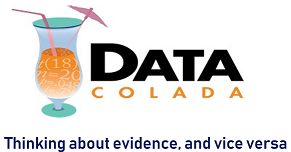For this post, the third in a series on Bayes factors (.htm), I wanted to get a sense for how Bayes factors were being used with real data from real papers, so I looked at the 10 most recent empirical papers in Psychological Science containing the phrase "Bayes factor" (.zip). After browsing them all, I…
[78b] Hyp-Chart, the Missing Link Between P-values and Bayes Factors
Just two steps are needed to go from computing p-values to computing Bayes factors. This post explains both steps and introduces Hyp-Chart, the missing link we arrive at if we take only the first step. Hyp-Chart is a graph that shows how well the data fit the null vs. every possible alternative hypothesis [1]. Hyp-Chart…
[78a] If you think p-values are problematic, wait until you understand Bayes Factors
Would raising the minimum wage by $4 lead to greater unemployment? Milton, a Chicago economist, has a theory (supply and demand) that says so. Milton believes the causal effect is anywhere between 1% and 10%. After the minimum wage increase of $4, unemployment goes up 1%. Milton feels bad about the unemployed but good about…
[77] Number-Bunching: A New Tool for Forensic Data Analysis
In this post I show how one can analyze the frequency with which values get repeated within a dataset – what I call “number-bunching” – to statistically identify whether the data were likely tampered with. Unlike Benford’s law (.htm), and its generalizations, this approach examines the entire number at once, not only the first or…
[76] Heterogeneity Is Replicable: Evidence From Maluma, MTurk, and Many Labs
A number of authors have recently proposed that (i) psychological research is highly unpredictable, with identical studies obtaining surprisingly different results, (ii) the presence of heterogeneity decreases the replicability of psychological findings. In this post we provide evidence that contradicts both propositions. Consider these quotes: "heterogeneity persists, and to a reasonable degree, even in […]…
[75] Intentionally Biased: People Purposely Don't Ignore Information They "Should" Ignore
You can’t un-ring a bell. Once people receive information, even if it is taken back, they cannot disregard it. Teachers cannot imagine what novice students don’t know, juries cannot follow instructions to disregard evidence, negotiators cannot take the perspective of their counterpart who does not know what they know, etc. People exhibit “Outcome bias”, “hindsight…
[74] In Press at Psychological Science: A New 'Nudge' Supported by Implausible Data
Today Psychological Science issued a Corrigendum (.htm) and an expression of concern (htm) for a paper originally posted online in May 2018 (.htm). This post will spell out the data irregularities we uncovered that eventually led to the two postings from the journal today. We are not convinced that those postings are sufficient. It is…
[73] Don't Trust Internal Meta-Analysis
Researchers have increasingly been using internal meta-analysis to summarize the evidence from multiple studies within the same paper. Much of the time, this involves computing the average effect size across the studies, and assessing whether that effect size is significantly different from zero. At first glance, internal meta-analysis seems like a wonderful idea. It increases…
[72] Metacritic Has A (File-Drawer) Problem
Metacritic.com scores and aggregates critics’ reviews of movies, music, and video games. The website provides a summary assessment of the critics’ evaluations, using a scale ranging from 0 to 100. Higher numbers mean that critics were more favorable. In theory, this website is pretty awesome, seemingly leveraging the wisdom-of-crowds to give consumers the most reliable…
[71] The (Surprising?) Shape of the File Drawer
Let’s start with a question so familiar that you will have answered it before the sentence is even completed: How many studies will a researcher need to run before finding a significant (p<.05) result? (If she is studying a non-existent effect and if she is not p-hacking.) Depending on your sophistication, wariness about being asked…
